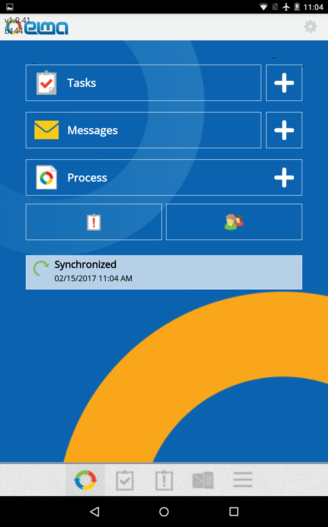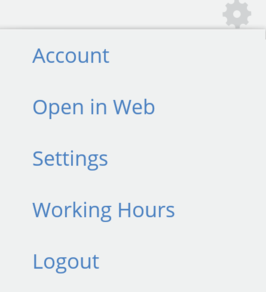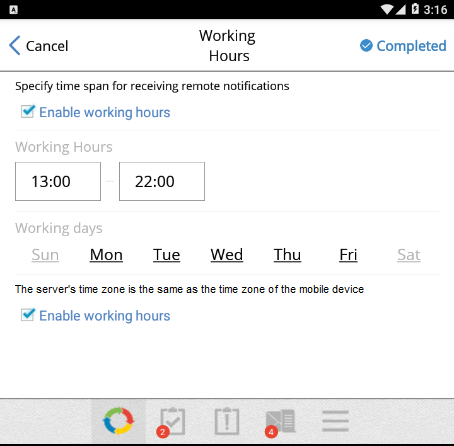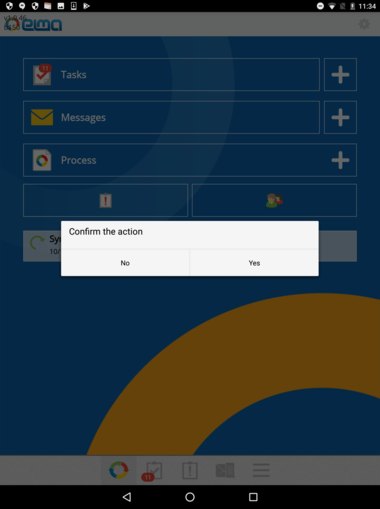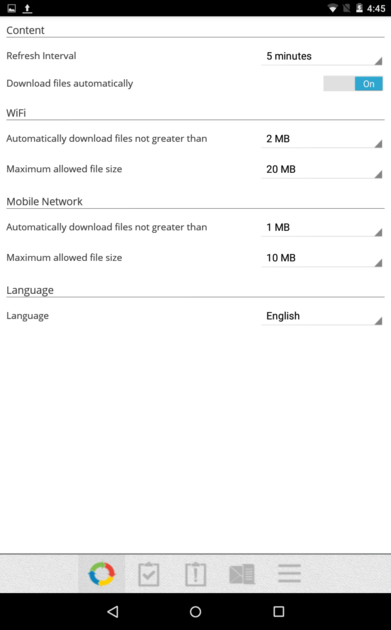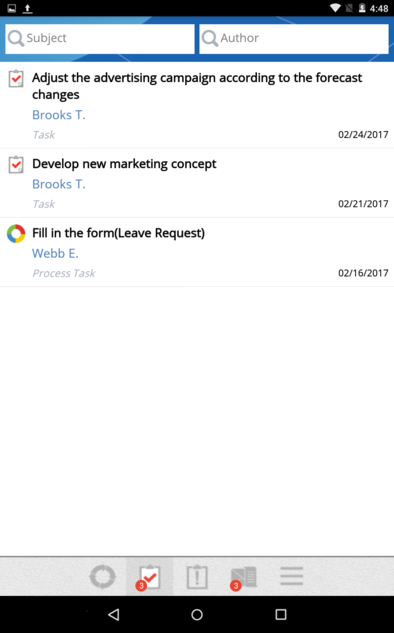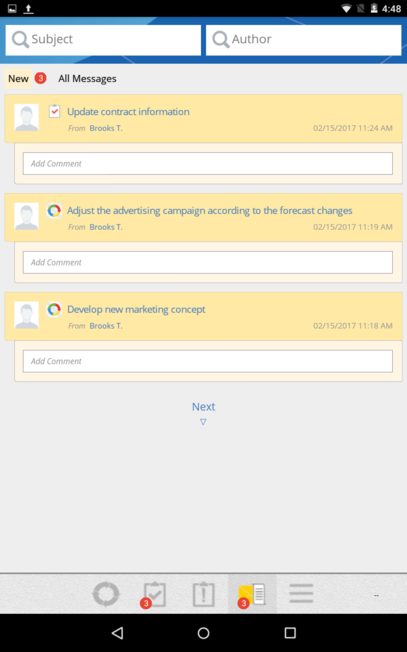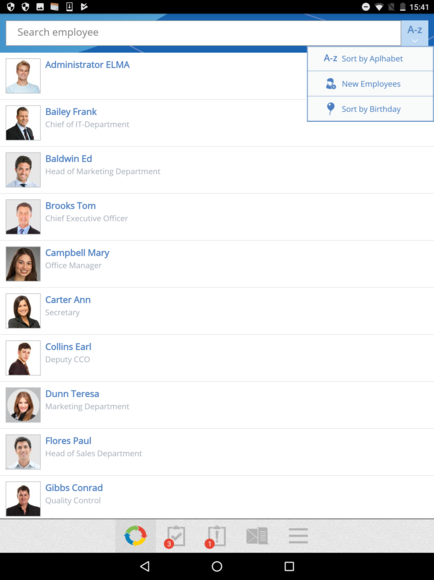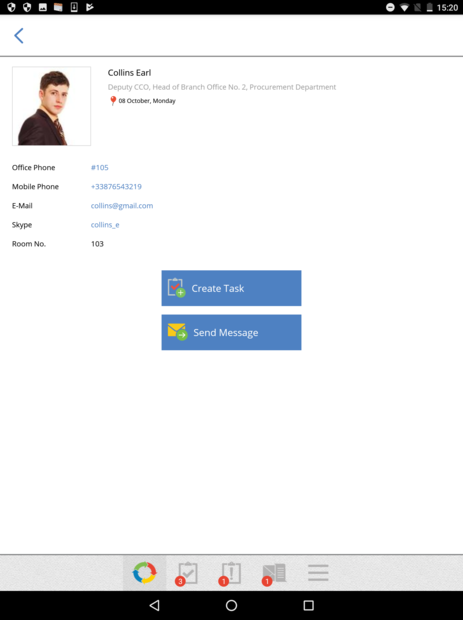Mobile Application for Android
ELMA BPM mobile application allows you to work with messages and processes and with three task categories:
To update information in one of the app's sections, swipe down. To update all the data in all of the sections, tap Synchronize.
An example of the main page is in fig. 1.
The main page includes 6 main buttons, the lower menu, and the settings button, located in the upper right corner of the screen. The lower menu is displayed in all application sections.
Main page buttons
|
|
|
|
|
|
|
|
|
|
|
Tap to open the page with tasks controlled by the current user.
|
|
|
Tap to open the list of system users with the user search form.
|
|
|
When you tap on this button, the tasks and messages lists are updated. This button also displays information on the latest synchronization.
If you have been working in the application without the Internet connection, tap this button to synchronize changes with the server, once the connection is established. You can also configure automatic synchronization. If there is no connection to the Internet, the synchronization icon shows the number of packages that will be sent to the server.
|
|
|
Go to the main page.
|
|
|
Go to the Tasks section. The number shows how many active tasks the current user has.
|
|
|
Go to the Control section. The number shows how many tasks this section contains.
|
|
|
Go to the Messages section. The number shows how many unread messages this section contains.
|
|
|
|
Additional application features
In the upper right corner of the main page there is a button  that, when tapped, opens a drop-down menu (Figure 2) with a list of additional features.
that, when tapped, opens a drop-down menu (Figure 2) with a list of additional features.
|
|
|
Fig. 2 ELMA BPM for Android. List of additional features
|
1. Account. Tap to open a page with the information about the user (Figure 3), under whose credentials the system was logged in.
This page also contains:
-
Server address in the format http://<ELMA_server_address>:<port>;
-
Open in Web button that opens the main page of Web Application in the browser;
-
Close button to go back to the main menu of the mobile application.
|
|
|
Fig. 3 ELMA BPM for Android. User account
|
2. Open in Web. Tap to open ELMA in the web browser.
3. Settings. Tap to open application settings page (fig. 6)
4. Push Settings. Tap to open a page where you can set up the time period for receiving notifications. By default this options is disabled. To activate it, select the "Enable" checkbox at the top of the page.
|
|
|
Fig. 4 ELMA BPM for Android. Setting up working hours
|
You can set the time when you want to receive notifications. For example, you can select only working days and set the working hours from 9:00 to 18:00. In this case, you will receive ELMA notifications on you mobile only from Monday to Friday from 9:00 to 18:00.
In addition, you can schedule mobile notifications according to the server time zone or your mobile device time zone. In the case of the latter, the time and date of notifications will be set to the time zone that you're currently in.
Once all settings are configured, click the Complete button.
5. Logout. When you click this button, a confirmation window opens (Figure 5).
|
|
|
Fig. 5 ELMA BPM for Android. Confirmation window
|
To open the application settings (Figure 6) tap Settings - Application settings, located at the bottom of the main page. You can configure settings in the offline mode.
|
|
|
Fig. 6 Application settings window
|
Content unit
-
Refresh Interval – time period for updating the list of tasks and messages;
-
Use lazy loading – allow using lazy loading of files; the lazy loading technology allows to defer loading of an object until the point at which it is needed;
-
Mark tasks for the following - select the time interval to mark tasks that will expire soon. Tasks that fall within this interval will be highlighted green in the Tasks section.
WiFi unit
-
Automatically download files not greater than – maximum size of files, which can be automatically downloaded using WiFi;
-
Maximum allowed file size – maximum size of files, which can be downloaded using WiFi.
Mobile Network unit
-
Automatically download files not greater than – maximum size of files, which can be automatically downloaded using the mobile network;
-
Maximum allowed file size – maximum size of files, which can be downloaded using the mobile network.
Language unit
-
Language – select the interface language;
This section displays the list with all the incoming tasks of the user (fig. 4).
Tasks will be available to users even if the mobile device is not connected to the Internet. The list will contain the latest synchronized tasks.
Each task has the following information: task subject, author, type and due date.
Top menu of the section contains two search strings (fig. 8):
|
|
|
Fig. 8. Top menu of the Tasks section
|
This section displays the tasks, under control of the current user (fig. 9).
This section consists of two tabs:
-
Completion Check – this tab displays the tasks with the Completion Check control type;
-
Task Monitoring – this tab displays the tasks with the Task Monitoring control type.
The active tab is highlighted yellow.
The information on these tabs is displayed as lists, as in the Tasks section.
The top menu of this section is similar to the top menu of the Tasks section.
This section is also available when your mobile device is offline.
This section displays all the messages of the current user. This section is similar to the Messages section in ELMA Web Application (fig. 10). When the mobile device is not connected to the Internet, users can create and read messages - the section displays all the synchronized messages.
|
|
|
Fig. 10. Messages section
|
Users section
This section can be accessed from the main page of the application by tapping the Users button. It displays the list of company's employees.
|
|
|
Fig. 11. ELMA BPM for Android. Users section
|
If necessary, you can change the way employees are sorted in the list. To do this, click on the button to the right of the employee search form and select one of the sorting options:
• Sort by Alphabet. The list is sorted alphabetically and includes all employees of the company.
• New Employees. Only new employees are listed.
• Sort by Birthday. The list displays all employees who have specified their birthday in user profiles. The upcoming birthdays are displayed at the top. Employees whose birthdays have already passed are displayed at the end of the list.
Tap an employee's name or avatar to open the user profile (Figure 12).
|
|
|
Fig. 12. ELMA BPM for Android. Users profile
|
This page contains the user's personal and contact information. You can also assign a task or send a message to the selected user from their profile.
Copyright © 2006–2019 ELMA

